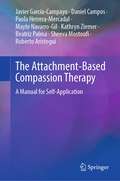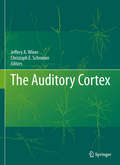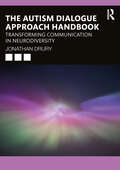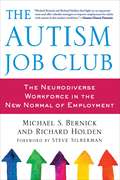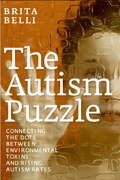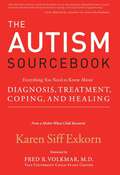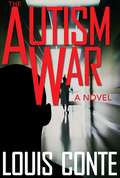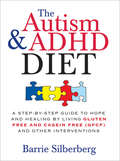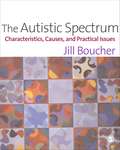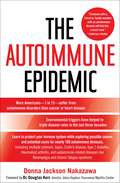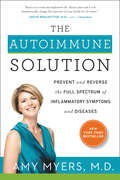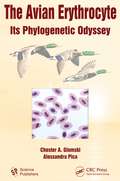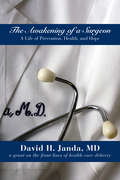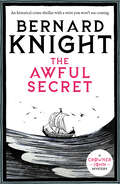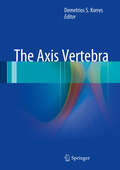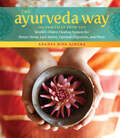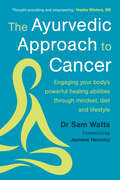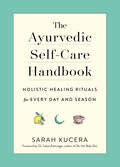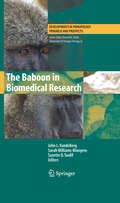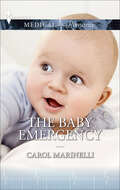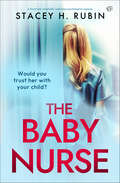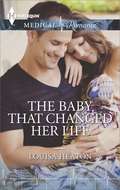- Table View
- List View
The Attachment-Based Compassion Therapy: A Manual for Self-Application
by Daniel Campos Roberto Aristegui Javier García-Campayo Paola Herrera-Mercadal Mayte Navarro-Gil Kathryn Ziemer Beatriz Palma Sheeva MostoufiThis book is a manual for self-application of the Attachment-Based Compassion Therapy (ABCT) protocol, that can be either self-applied by any individual in a psychoeducational context or as a support for a therapeutic process guided by a professional. Compassion therapy is a third-generation psychotherapy that has been used in association with mindfulness in recent years. In particular, attachment-based compassion therapy (ABCT) is a protocol that can be used in both the general and psychiatric population with the aim of promoting compassion and self-compassion. ABCT is based on attachment theory and, therefore, includes practices to raise awareness and/or address maladaptive aspects, where appropriate, of the attachment styles developed with parents. This process is taught as a form of both compassion and self-compassion in order to improve present-day interpersonal relationships and well-being in general. In the face-to-face group format, ABCT has been demonstrating efficacy and applicability for healthy people and for the treatment of fibromyalgia, depression, anxiety and adjustment disorders. This book presents a self-applied version of ABCT that operates along the lines of the original model and has been adapted and developed to be fully self-applied via the Internet in 8 sequential modules:Introduction to attachment-based compassion therapyPreparing ourselves for compassion: kind attentionDiscovering our compassionate worldDeveloping our compassionate worldUnderstanding our relationship with compassionWorking on ourselvesUnderstanding the importance of forgivenessConsolidating the practice of compassion The content is presented through texts, pictures, tables and figures, including links to downloadable audio files for formal meditation practices with specific guides and instruction for each meditation. The transcripts to each guided meditation are also included as appendices.
The Auditory Cortex
by Christoph E. Schreiner Jeffery A. WinerThere has been substantial progress in understanding the contributions of the auditory forebrain to hearing, sound localization, communication, emotive behavior, and cognition. The Auditory Cortex covers the latest knowledge about the auditory forebrain, including the auditory cortex as well as the medial geniculate body in the thalamus. This book will cover all important aspects of the auditory forebrain organization and function, integrating the auditory thalamus and cortex into a smooth, coherent whole. Volume One covers basic auditory neuroscience. It complements The Auditory Cortex, Volume 2: Integrative Neuroscience, which takes a more applied/clinical perspective.
The Autism Dialogue Approach Handbook: Transforming Communication in Neurodiversity
by Jonathan DruryThe Autism Dialogue Approach Handbook serves as both a comprehensive guide and a practical handbook for healthcare professionals, educators, caregivers and anyone engaging with the autism community. Jonathan Drury presents the Autism Dialogue Approach (ADA), a pioneering framework rooted in dialogue and mindfulness practices. It addresses the diverse needs of autistic and neurodivergent individuals, emphasising that ‘the autism community’ includes everyone, promoting an inclusive understanding of neurodiversity.The book critiques traditional therapeutic and coaching models, proposing ADA as an alternative that values co-creation and shared meaning-making. By exploring practical strategies, Drury demonstrates how ADA transforms therapy, coaching and leadership by fostering environments where neurodivergent and neurotypical individuals can connect authentically and transcend division. With clear tools, exercises and real-world examples, this handbook guides readers in applying ADA to cultivate neurodivergent-affirming, inclusive spaces. It also delves into the philosophical and spiritual dimensions of dialogue, offering insights into how societal structures impact autistic experiences and how systemic change can occur through dialogue.Aimed at those committed to building compassionate and inclusive settings, this handbook equips readers with practical skills for nurturing deep connections, promoting wellbeing and driving societal transformation through a neurodiversity-affirming approach.
The Autism Job Club: The Neurodiverse Workforce in the New Normal of Employment
by Steve Silberman Richard Holden Michael BernickThe Autism Job Club is a groundbreaking book for bringing adults with autism and other neuro-diverse conditions into the work world. This second edition of The Autism Job Club includes a new Foreword by Steve Silberman, author of the best-selling NeuroTribes, along with an Afterword by the authors. The Afterword covers the many employment initiatives for adults on the autism spectrum launched just in the three years since the book was originally published. The book has its basis in the autism job club that the authors have been part of in the San Francisco Bay Area, the job-creation and job-placement efforts the club has undertaken, and similar efforts throughout the United States. The authors review the high unemployment rates among adults with autism and other neuro- diverse conditions more than two decades after the ADA. Bernick and Holden also outline and explain six strategies that, taken together, will reshape employment for adults with autism: the art of the autism job coach; the autism advantage in technology employment; autism employment and the internet economy; autism employment and the practical/craft economy; autism and extra-governmental job networks; autism and public service employment.The Autism Job Club is a vital resource for adults with autism, their families, and advocates who are committed to neuro-diverse employment, not unemployment. But it also speaks to a far broader audience interested in how to carve out a place for themselves or others in an increasingly competitive job world.
The Autism Puzzle
by Brita BelliThe alarming spike in autism in recent years has sent doctors and parents on a search for answers. And while many controversies have erupted around the issue, none have gotten us any closer to a definitive explanation, and many key concerns remain unexplored. Moving beyond the distractions of the vaccine debate, The Autism Puzzle is the first book to address the compelling evidence that it is the pairing of environmental exposures with genetic susceptibilities that may be impacting the brain development of children. Journalist Brita Belli brings us into the lives of three families with autistic children, each with different ideas about autism, as she explores the possible causes. She interprets for readers compelling evidence that environmental toxins--including common exposures from chemicals mounting in our everyday lives--may be sparking this disorder in vulnerable children. Belli calls for an end to the use of hazardous materials--like toxic flame retardants used in electronics and furniture, which have been banned elsewhere--insisting that we cannot afford to experiment with our children. The Autism Puzzle puts a human face on the families caught in between the debates, and offers a refreshingly balanced perspective.
The Autism Sourcebook: Everything You Need to Know About Diagnosis, Treatment, Coping, and Healing
by Karen Siff ExkornPractical advice and information from the world's foremost experts on autism -- and a mother's own hard-won lessons from helping her son recover from the disorderWhen Karen Siff Exkorn's son, Jake, was diagnosed with autism, she struggled to pull together comprehensive information about the disorder. Fortunately, she was able to educate herself quickly, and her extensive at-home treatment of her son led to his amazing full recovery. But the journey wasn't easy, and now, in The Autism Sourcebook, Siff Exkorn offers parents the wisdom she wishes she'd had at the beginning.Recent studies show that there is a worldwide epidemic of autism. More than 1.5 million people are affected in the United States alone, with one in every 166 children diagnosed. Early detection and early intervention are two of the key factors in improving prognosis -- but too often, writes Siff Exkorn, parents get bogged down in denial or confusion about the still mysterious disorder, and are unable to take the necessary steps. Providing accessible medical information gleaned from the world's foremost experts, Siff Exkorn offers an inside look at families with children who have autism, and ties in her own firsthand experience as a parent. The author shares valuable knowledge about the following:What the diagnosis really meansUnderstanding and accessing treatment optionsKnowing your child's rights in the school systemCoping with common marital and familial stressMaking the stigma of autism a thing of the pastWith extensive appendices, including the Modified Checklist for Autism in Toddlers, Diagnostic Criteria for the Five Pervasive Developmental Disorders, and carefully selected lists of Internet resources, recommended readings, and top autism organizations worldwide, The Autism Sourcebook is the single most comprehensive, practical resource available to parents and loved ones of children with autism.
The Autism War: A Novel
by Louis ConteTony Colletti, a good suburban cop and father, finds himself drawn into the controversy over vaccines and autism when he tries to uncover the truth behind the shadowy Vaccine Court. His dangerous journey forces him to will risk his life and honor while confronting corrupt government officials, the powerful pharmaceutical industry, and disturbing elements of his own past. Colletti and his allies battle spies, Russian gangsters, and sexual predators preying upon disabled children. They go to war against foes who manipulate the media, fabricate scientific research, and viciously attack those who question vaccine safety.In this gripping novel, government and industry have formed an unholy alliance that places profit ahead of children's health, one that makes ordinary Americans fight back to protect their families and the ideals of justice. Echoing the infamous Minimata, Japan, mercury poisoning tragedy, The Autism War shows how history can repeat when humanity fails to heed the lessons of the past.
The Autism and ADHD Diet
by Barrie SilberbergThis is what parents are saying about an amazing diet that is showing extraordinary results in helping children eliminate many traits and symptoms associated with autism spectrum disorders, ADHD, celiac disease, and other conditions. The Gluten-Free, Casein-Free (GFCF) Diet, as well as removing all artificial dyes and preservatives, is hugely effective for thousands of families. The Autism & ADHD Diet is your complete guide to the GFCF Diet. Barrie Silberberg, a mother who honed her skills using the GFCF Diet with her son, who was diagnosed with ASD, gives you everything you need to know to put the diet into action with your child, including: * What the GFCF Diet is and why it's so effective * How to start the diet * Where and how to buy GFCF foods * How to avoid cross-contamination * How to understand labels on packaging * How to make this diet work day-to-day Packed with parent-proven tips and the best resources for the diet, The Autism & ADHD Diet will alleviate all of your questions and provide a variety of ways to make this diet work best for you and your family.
The Autistic Spectrum
by Jill BoucherA complete historical and factual overview of Autism and Asperger's Syndrome which also covers the psychological approaches for the understanding and treatment of these conditions.
The Autoimmune Epidemic: Bodies Gone Haywire in a World Out of Balance--and the Cutting-Edge Science that Promises Hope
by Donna Jackson NakazawaFrom the foreword by Dr. Douglas Kerr, Director, Johns Hopkins Transverse Myelitis Center "The Autoimmune Epidemic by Donna Jackson Nakazawa is an astounding book....It is the kind of book that will rivet you and scare you. It will make you angry. It will amaze you with the courage of some of the people described in the book...The Autoimmune Epidemic is every bit as compelling as Upton Sinclair's The Jungle...It is also every bit as necessary as An Inconvenient Truth.... You will leave this book with no reservations about the veracity of the conclusions: put simply, there is no doubt that autoimmune diseases are on the rise and increasing environmental exposures of toxins and chemicals is fueling this rise. The research is sound. The conclusions unassailable.... Reading The Autoimmune Epidemic is a necessary first step. Reading The Autoimmune Epidemic is a life-altering event. It needs to be."
The Autoimmune Solution: Prevent and Reverse the Full Spectrum of Inflammatory Symptoms and Diseases
by Amy MyersOver 90 percent of the population suffers from inflammation or an autoimmune disorder. Until now, conventional medicine has said there is no cure. Minor irritations like rashes and runny noses are ignored, while chronic and debilitating diseases like Crohn's and rheumatoid arthritis are handled with a cocktail of toxic treatments that fail to address their root cause. But it doesn't have to be this way.In The Autoimmune Solution, Dr. Amy Myers, a renowned leader in functional medicine, offers her medically proven approach to prevent and reverse a wide range of inflammatory-related symptoms and diseases, including allergies, obesity, asthma, cardiovascular disease, fibromyalgia, lupus, IBS, chronic headaches, and Hashimoto's thyroiditis.The Myers Way is built on four pillars: Eliminating toxic foods, such as sugar and caffeine, and inflammatory foods, like dairy, gluten, and grains, which disrupt our digestive system. Introducing restorative ingredients and sup-plements, such as quality proteins, healthy fats, and probiotics, to repair the gut. Identifying environmental toxins in everyday products like shampoo, soap, cosmetics, detergent, and other household products. Healing autoimmune-related infections while relieving the mental, emotional, and physical stress that exacerbate the immune system's response to external toxins.Through this program, Dr. Myers has suc-cessfully treated thousands of patients. Whether you're battling multiple sclerosis or Graves' disease, or you simply want to put an end to nagging minor symptoms, The Autoimmune Solution is a medical breakthrough, a prescriptive and easy-to-follow program designed to fight and defeat the full spectrum of autoimmune diseases.
The Avian Erythrocyte: Its Phylogenetic Odyssey
by Chester A. Glomski Alessandra PicaThe erythrocyte presents morphologic, cytochemical, and quantitative adaptations as it progresses through its evolutionary continuum. This text is a comprehensive exploration of the evolutionary relationship of the avian erythrocyte with the erythrocytes of the antecedent lower vertebrates-such as amphibians and reptiles-as well as mammalians. It a
The Awakening of a Surgeon
by David H JandaSports-related injuries have become a public health epidemic. Twelve million student athletes will suffer a sports-related injury this year. Nearly two million injuries will be in recreational softball games and baseball games. The majority of these injuries are preventable. The Awakening of a Surgeon outlines 20 strategies that can be implemented in every community to drastically reduce the possibility of injury and death.
The Awakening of a Surgeon
by David H JandaSports-related injuries have become a public health epidemic. Twelve million student athletes will suffer a sports-related injury this year. Nearly two million injuries will be in recreational softball games and baseball games. The majority of these injuries are preventable. The Awakening of a Surgeon outlines 20 strategies that can be implemented in every community to drastically reduce the possibility of injury and death.
The Awful Secret: An historical crime thriller with a twist you won't see coming (Crowner John Mysteries)
by Bernard KnightA terrible truth that could shake Christendom to its core.1195. Gilbert de Rideford – Knight of the Temple of Solomon and old acquaintance of county coroner Sir John de Wolfe – arrives in Exeter, begging for Sir John’s help.He claims to have come into possession of an incredible secret, but to reveal it, first he needs to escape beyond the reach of the Knights Templar, or the secretive order of warrior monks – his former comrades – will surely kill him.Suddenly swept into a world of religious intrigue and dangerous politics, Crowner John finds himself undertaking a life-threatening mission to Lundy, an island inhabited solely by notorious pirates, until finally the awful secret is finally revealed.An astounding medieval mystery that will keep you on the edge of your seat, perfect for fans of E. M. Powell, C. J. Sansom and Edward Marston.
The Axis Vertebra
by Demetrios S. KorresThe axis (second cervical) vertebra is of special interest owing to its particular anatomy, biomechanics, and position in the spine. Despite this, the role of the axis in the function of the cervical spine and the nature of its involvement in trauma and other pathological conditions are still not completely understood. This book covers all aspects of the axis vertebra and its disorders. Embryologic development, normal anatomy, and biomechanics of the axis and upper cervical spine are first discussed, and imaging appearances explained with the aid of standard radiographs and images obtained using advanced techniques. Congenital anomalies, fractures, infections, and tumors (benign and malignant) are then discussed in depth in individual sections. The book is based on the personal experience and expertise of the contributing authors, enhanced by up-to-date information drawn from the literature, and will appeal to a range of practitioners.
The Ayurveda Way: 108 Practices from the World's Oldest Healing System for Better Sleep, Less Stress, Optimal Digestion, and More
by Ananta Ripa AjmeraCelebrated Ayurveda teacher Ananta Ripa Ajmera offers an inspiring introduction to this ancient Indian medical tradition, which complements and extends the health and wellness benefits of yoga. Through 108 short essays you will learn to approach optimal digestion, better sleep, less stress, and a more balanced life. Diet is key, and many essays are accompanied by recipes that incorporate into daily meals spices such as turmeric, cumin, ginger, and mustard seeds. In addition, meditation, yoga and breathing exercises, and self-care practices such as oil pulling and massage, make this time-tested wisdom available to contemporary holistic health enthusiasts — even beginners.
The Ayurvedic Approach to Cancer: Engaging your body’s powerful healing abilities through mindset, diet and lifestyle
by Dr. Sam WattsHarness the power of your body to heal through clinically proven, natural, Ayurvedic holistic practices. Optimise your mental and emotional health using the psychology of exceptional survival. Understand practical, straightforward changes to your diet to boost your natural immunity and gut health. Practise the science of circadian medicine as well as the healing benefits of nature immersion, meditation and visualisation, breathing techniques and clinically proven herbal medicines and supplements. The Ayurvedic Approach to Cancer aims to break new ground with its unique approach to supporting those living with cancer by integrating the holistic practices of Ayurveda, a natural system of medicine, with the most advanced, cutting-edge science from the field of exceptional cancer survivorship research. Sam Watts has a PhD in cancer survivorship from the University of Southampton. He is also a trained clinical practitioner of Ayurveda. Sam has led large-scale, NHS-funded clinical investigations of people living with incurable cancers who defy the statistical odds. Sam’s research has been focused on finding consistencies in the practices that the majority of these cancer patients adopt because he believes that it is very likely that these practices will help us understand what allowed them to become exceptional. His research has indeed found such consistencies and, as an Ayurvedic practitioner, he has also realised that the majority of them fall under the framework of Ayurveda. Over the last decade, Ayurveda has become one of the most-utilised forms of complementary medicine adopted by those living with cancer. In this book, Sam has integrated his exceptional cancer survivorship research and Ayurveda practices into a practical and easy-to-follow blueprint that will engage the body’s natural ability to heal so you can live with cancer with vitality, well-being and optimism.
The Ayurvedic Self-Care Handbook: Holistic Healing Rituals For Every Day And Season
by Sarah KuceraAncient self-care for modern life, by the author of the forthcoming The Seven Ways of Ayurveda Feeling burned-out, unmotivated, or stuck? The Ayurvedic Self-Care Handbook is here to help. This authoritative guide to ancient healing offers more than 100 daily and seasonal Ayurvedic rituals—each taking 10 minutes or less—to reconnect you with nature’s rhythms, and to unlock better health, as you: Boost and stabilize your energy with yogic breathing Overcome transitions with grounding meditations Undo physical and emotional stress with personalized yoga postures Prevent and treat disease with nourishing tonics and teas Pause and reflect with daily and weekly journaling prompts. Get back in sync with nature—and rediscover your potential to feel good.
The BMT Data Book
by FACP Hillard M. Lazarus Fracp Reinhold Munker MD Gerhard C. Hildebrandt MD Hillard M. Lazarus Kerry Atkinson Frcp Gerhard C. HildebrandtThe BMT Data Book is an essential guide to the data, outcome studies and complex decision-making processes involved in blood and marrow stem cell transplantation. Organized according to types of diseases and procedures, it contains more than hundred table
The Baboon in Biomedical Research
by Suzette D. Tardif John L. Vandeberg Sarah Williams-BlangeroThe present volume was written to provide an overview of many diverse areas of biomedical research to which the baboon has made and continues to make important contributions. Each chapter reviews the recent literature on the topic, discusses work in progress, and presents the authors' vision of research opportunities and likely future contributions of the baboon model to human medicine. The baboon is a relative newcomer to the repertoire of nonhuman primates used in biomedical research. However, in less than 50 years since its first use in the U.S. it has become one of the most popular laboratory primate species. It is larger than the other widely used monkey species, making it advantageous for many types of experiments and technological developments. It is extraordinarily hardy and highly fecund in captivity. It closely resembles humans in a variety of physiological and disease processes, such as cholesterol metabolism, early stages of atherosclerosis, and alcoholic liver disease. Its chromosomes closely resemble those of humans, and many genes of the two species lie in the same chromosomal order. Among all primates, baboons are the most widely used as models for the genetics of susceptibility to complex diseases and they are the first nonhuman primate for which a framework genetic linkage map was established. In addition, the baboon genome is currently being sequenced, and as a result the utility of this species for biomedical research will be dramatically increased. For all of these reasons, the baboon is certain to continue as one of the premier nonhuman species used in medical research.
The Baby Doctor's Bride
by Jessica MatthewsNewly qualified pediatrician Ivy is in over her head, so when she hears that a retired doctor has moved into the area, she's determined to use her many charms to get him to help out at her practice. Expecting a man in his dotage, she's pleasantly surprised to find that Ethan Locke is in his prime! But the handsome doctor is far from easy to convince. He's adamant that he'll be no good for the practice, or for Ivy.Ethan is grieving the loss of his infant son and the breakup of his relationship. He's terrified that he's lost his touch when it comes to both treating children and dealing with women. But something about Ivy makes her hard to resist, and he soon finds himself firmly ensconced at the practice and in Ivy's life. Dare he hope he's finally found the future he's been longing for?
The Baby Emergency (Tennengarrah Clinic #1)
by Carol MarinelliThe doctor and the single momWhen Shelly Weaver returns to the children's ward for her first night shift as a single mom, she discovers it's also Dr. Ross Bodey's first night back. He's been working in the Outback, but on discovering Shelly's newly single status he's returned—for her!Shelly didn't know Ross was in love with her—until now. And suddenly Ross is asking her to change her life forever. But Shelly has her son to consider, although he is falling in love with Ross as quickly as Shelly is….
The Baby Nurse
by Stacey RubinShe&’s trained to save fragile lives. But how far will she go to protect just one? Twenty-six-year-old NICU nurse Annabelle Kaplan is devoted to the preterm infants in her care—even as her own life quietly unravels. Haunted by the stillbirth of her daughter and drowning in secret debt from compulsive shopping, Annabelle clings to her work as a lifeline. When a tragic accident leaves her beloved patient, Baby Olivia, orphaned, Annabelle&’s world tilts again. Olivia is placed in the custody of her only relative—an aunt who seems more interested in money than motherhood. But when Annabelle witnesses the woman leaving Olivia alone in a car outside a bar, instinct overrides judgment. In a single, reckless moment, Annabelle drives away with the baby. What begins as a few hours of comfort spirals into a desperate, dangerous attempt to keep Olivia safe. As the days pass, Annabelle&’s choices threaten her marriage, her career, and her freedom. And when a chilling ultimatum appears—return the baby or Annabelle&’s husband, Peter, will suffer—Annabelle must make an unthinkable decision.&“The Baby Nurse is an emotional roller coaster, a gripping psychological thriller that explores the fine line between love and obsession.&” —Rebecca Drake, author of Just Between UsA moving portrait of grief, resilience, and redemption, The Baby Nurse explores the line between right and wrong, and how love sometimes means letting go.
The Baby That Changed Her Life
by Louisa Heaton"You're pregnant." When midwife Callie Taylor agreed to be the surrogate mother for her best friend, Dr. Lucas Gold, she couldn't have predicted that his marriage would fall apart exactly when she became pregnant with his child... Suddenly her life has changed forever, and Callie's terrified of becoming a mom to the baby she never dreamed of keeping. Even more terrifying are the feelings she's starting to develop for Lucas-feelings that have nothing to do with her hormones...and absolutely everything to do with his scorching kiss!
